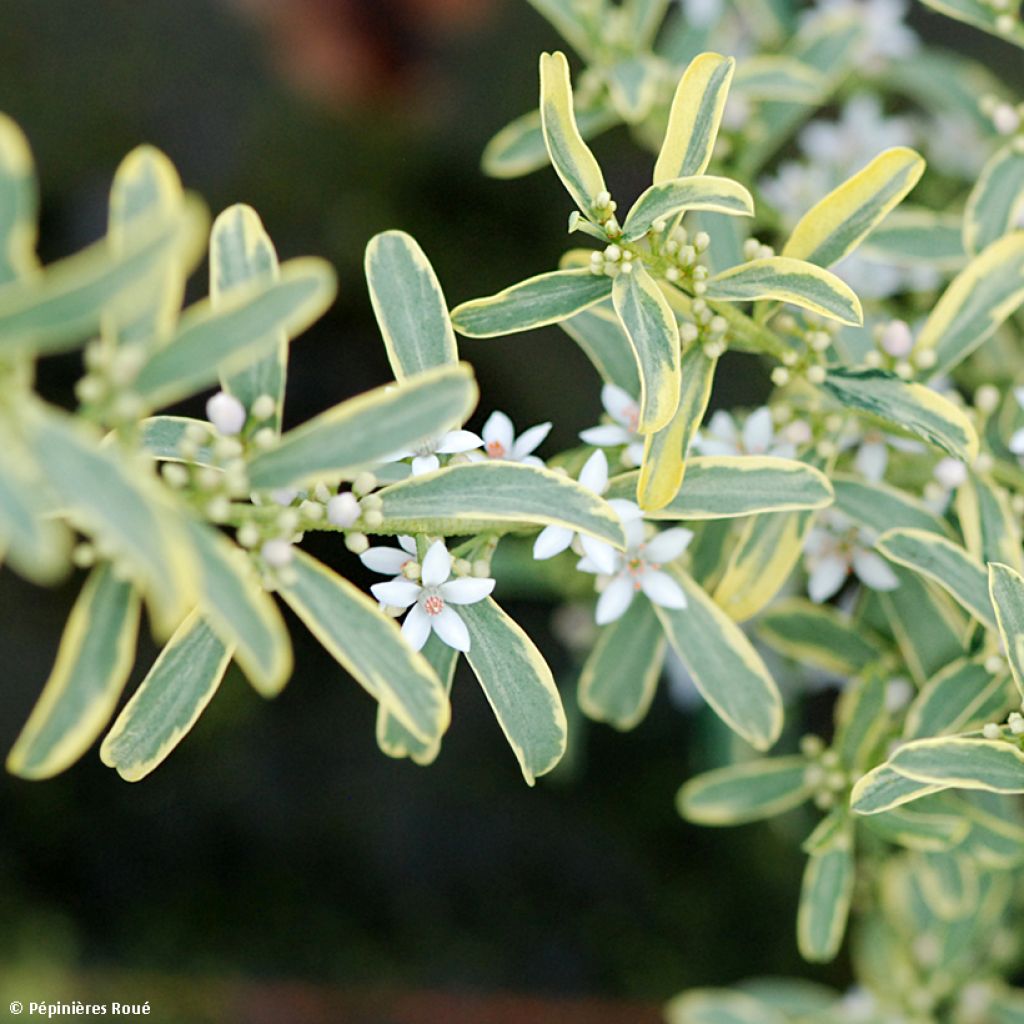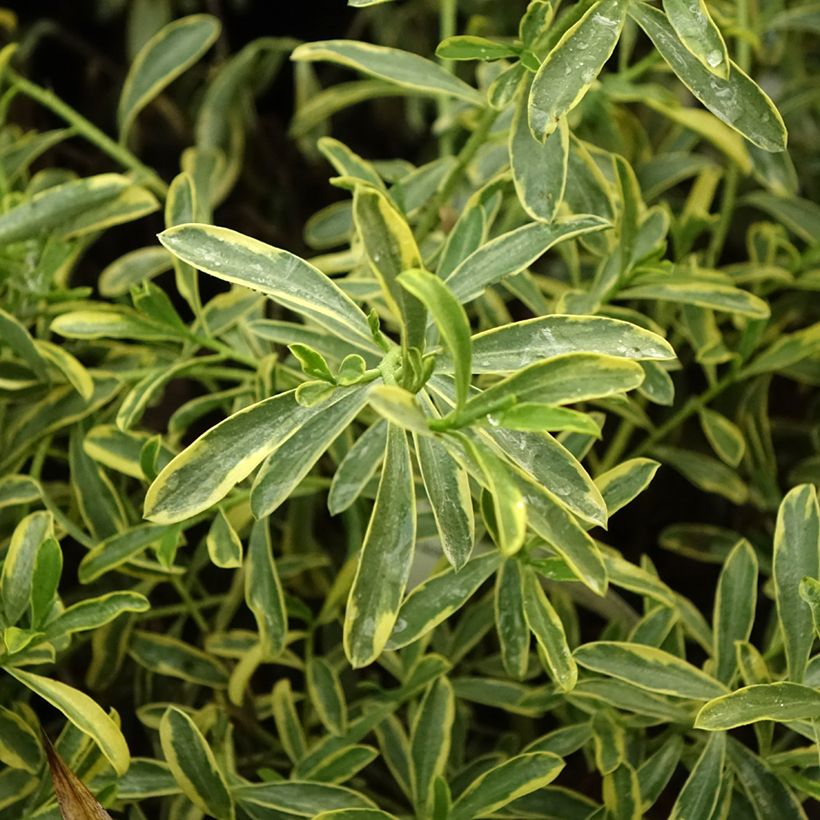

Eriostemon myoporoides GOLD TOUCH


Eriostemon myoporoides GOLD TOUCH


Eriostemon myoporoides GOLD TOUCH


Eriostemon myoporoides GOLD TOUCH


Eriostemon myoporoides GOLD TOUCH
Eriostemon myoporoides GOLD TOUCH
Eriostemon myoporoides GOLD TOUCH 'Panroue'
Long-leaf Wax Flower
Special offer!
Receive a €20 voucher for any order over €90 (excluding delivery costs, credit notes, and plastic-free options)!
1- Add your favorite plants to your cart.
2- Once you have reached €90, confirm your order (you can even choose the delivery date!).
3- As soon as your order is shipped, you will receive an email containing your voucher code, valid for 3 months (90 days).
Your voucher is unique and can only be used once, for any order with a minimum value of €20, excluding delivery costs.
Can be combined with other current offers, non-divisible and non-refundable.
Home or relay delivery (depending on size and destination)
Schedule delivery date,
and select date in basket
This plant carries a 24 months recovery warranty
More information
We guarantee the quality of our plants for a full growing cycle, and will replace at our expense any plant that fails to recover under normal climatic and planting conditions.
Would this plant suit my garden?
Set up your Plantfit profile →
Description
The Eriostemon or Philotheca myoporoides Gold Touch is a bright bush, particularly floriferous and pleasantly aromatic, which will delight enthusiasts of Australian plants. It forms a light and overall rounded mass, covered with fine variegated foliage on which a myriad of small white star-shaped flowers bloom, with a sweet and sugary fragrance. It blooms from the end of winter and throughout a long period. If you have a garden located on a coastal facade, this variegated Eriostemon should thrive in open ground in your garden, in a heathland bed. As it performs well in pots, gardeners in more continental climates can admire it on the terrace throughout the summer season and bring it indoors during winter in a lightly heated greenhouse or conservatory.
The Myoporum-flowered Philotheca is a plant from the Rutaceae family, native to southeastern Australia. Its natural habitat consists of open forested areas. Now classified in the genus Philoteca, this bush is relatively unknown in France. With a winter flowering, or at least early flowering, it appeared in Europe in the 1820s. Comfortable in neutral to acidic soils, the plant is water-efficient and can withstand short frosts of around -7°C (19.4°F).
The Philotheca myoporoides Gold Touch 'Panroue' is a variegated horticultural selection that has received the Bronze Medal at the Plantarium New Varieties Competition 2022. The plant forms a generally rounded bush with a dense and light habit, reaching about 1.20 m (4ft) in all directions but often wider than tall. Branching from the base, it has warty stems that bear evergreen leaves, oblong in shape, pointed at their tips, measuring less than 10 cm (4in). Their thick lamina is green with cream margins. When crushed, they release an aroma reminiscent of orange blossom. In mild climates, the flowers appear from October, grouped in clusters of 3 to 5 pink buds, in the axils of the leaves. The flowering lasts until March. In cooler climates, it extends from February to May. The buds open into a small star-shaped corolla composed of 5 waxy white petals, sometimes tinged with pink, surrounding fused orange stamens. These flowers measure 1 cm (1in) wide, but they are so numerous in winter and spring that they almost make the foliage disappear.
The Eriostemon Gold Touch prefers partial shade and mild climates. Its requirements are clear and must be respected in order to succeed in its cultivation and enjoy its beauty. Outside of certain well-targeted areas of our Mediterranean coast or, more broadly, along the Atlantic facade, it seems preferable to cultivate it in a pot, whose substrate and wintering conditions can be controlled. In the garden, it can be paired with other Australian plants, such as Boronia heterophylla, Galvezia speciosa, Gomphostigma virgatum, or white, pink, or red heathland shrubs. On the terrace or balcony, it can be surrounded by Dark Blue Plumbago with its long blue flowering, a Tibouchina, or a Leptospermum Wiri Kerry.
Report an error about the product description
Eriostemon myoporoides GOLD TOUCH in pictures






Plant habit
Flowering
Foliage
Botanical data
Eriostemon
myoporoides
GOLD TOUCH 'Panroue'
Rutaceae
Long-leaf Wax Flower
Australia
Other Eriostemon - Philotheca
View all →Planting and care
The Philotheca myoporoides Gold Touch is hardy down to -7 °C, in very well-drained soil. It tolerates drought once established, as well as sea spray. Plant it in the ground or in pots preferably in spring. Choose a sunny but not scorching or partially shaded location, which it particularly appreciates in hot climates. The soil should be light, well-drained, low to non-calcareous, and neutral to acidic: a mix of heath soil, sand, and compost is ideal. Water the Eriostemon with non-calcareous or slightly calcareous water in summer for the first two years if it is in the ground.
If grown in a pot, it should be moved outside once heavy frost is no longer a concern. Choose a large container, as the planting substrate should always retain some moisture. Store your bush frost-free in autumn, in a cold greenhouse or an unheated conservatory, as it still needs some cold to induce its flower buds.
Pruning is not necessary, except to remove dead branches or rebalance the habit. However, to make it denser, the tips of the branches can be lightly pruned just after flowering. Pruning later will compromise the following year's flowering.
Planting period
Intended location
Care
This item has not been reviewed yet - be the first to leave a review about it.
Similar products
Haven't found what you were looking for?
Hardiness is the lowest winter temperature a plant can endure without suffering serious damage or even dying. However, hardiness is affected by location (a sheltered area, such as a patio), protection (winter cover) and soil type (hardiness is improved by well-drained soil).

Photo Sharing Terms & Conditions
In order to encourage gardeners to interact and share their experiences, Promesse de fleurs offers various media enabling content to be uploaded onto its Site - in particular via the ‘Photo sharing’ module.
The User agrees to refrain from:
- Posting any content that is illegal, prejudicial, insulting, racist, inciteful to hatred, revisionist, contrary to public decency, that infringes on privacy or on the privacy rights of third parties, in particular the publicity rights of persons and goods, intellectual property rights, or the right to privacy.
- Submitting content on behalf of a third party;
- Impersonate the identity of a third party and/or publish any personal information about a third party;
In general, the User undertakes to refrain from any unethical behaviour.
All Content (in particular text, comments, files, images, photos, videos, creative works, etc.), which may be subject to property or intellectual property rights, image or other private rights, shall remain the property of the User, subject to the limited rights granted by the terms of the licence granted by Promesse de fleurs as stated below. Users are at liberty to publish or not to publish such Content on the Site, notably via the ‘Photo Sharing’ facility, and accept that this Content shall be made public and freely accessible, notably on the Internet.
Users further acknowledge, undertake to have ,and guarantee that they hold all necessary rights and permissions to publish such material on the Site, in particular with regard to the legislation in force pertaining to any privacy, property, intellectual property, image, or contractual rights, or rights of any other nature. By publishing such Content on the Site, Users acknowledge accepting full liability as publishers of the Content within the meaning of the law, and grant Promesse de fleurs, free of charge, an inclusive, worldwide licence for the said Content for the entire duration of its publication, including all reproduction, representation, up/downloading, displaying, performing, transmission, and storage rights.
Users also grant permission for their name to be linked to the Content and accept that this link may not always be made available.
By engaging in posting material, Users consent to their Content becoming automatically accessible on the Internet, in particular on other sites and/or blogs and/or web pages of the Promesse de fleurs site, including in particular social pages and the Promesse de fleurs catalogue.
Users may secure the removal of entrusted content free of charge by issuing a simple request via our contact form.
The flowering period indicated on our website applies to countries and regions located in USDA zone 8 (France, the United Kingdom, Ireland, the Netherlands, etc.)
It will vary according to where you live:
- In zones 9 to 10 (Italy, Spain, Greece, etc.), flowering will occur about 2 to 4 weeks earlier.
- In zones 6 to 7 (Germany, Poland, Slovenia, and lower mountainous regions), flowering will be delayed by 2 to 3 weeks.
- In zone 5 (Central Europe, Scandinavia), blooming will be delayed by 3 to 5 weeks.
In temperate climates, pruning of spring-flowering shrubs (forsythia, spireas, etc.) should be done just after flowering.
Pruning of summer-flowering shrubs (Indian Lilac, Perovskia, etc.) can be done in winter or spring.
In cold regions as well as with frost-sensitive plants, avoid pruning too early when severe frosts may still occur.
The planting period indicated on our website applies to countries and regions located in USDA zone 8 (France, United Kingdom, Ireland, Netherlands).
It will vary according to where you live:
- In Mediterranean zones (Marseille, Madrid, Milan, etc.), autumn and winter are the best planting periods.
- In continental zones (Strasbourg, Munich, Vienna, etc.), delay planting by 2 to 3 weeks in spring and bring it forward by 2 to 4 weeks in autumn.
- In mountainous regions (the Alps, Pyrenees, Carpathians, etc.), it is best to plant in late spring (May-June) or late summer (August-September).
The harvesting period indicated on our website applies to countries and regions in USDA zone 8 (France, England, Ireland, the Netherlands).
In colder areas (Scandinavia, Poland, Austria...) fruit and vegetable harvests are likely to be delayed by 3-4 weeks.
In warmer areas (Italy, Spain, Greece, etc.), harvesting will probably take place earlier, depending on weather conditions.
The sowing periods indicated on our website apply to countries and regions within USDA Zone 8 (France, UK, Ireland, Netherlands).
In colder areas (Scandinavia, Poland, Austria...), delay any outdoor sowing by 3-4 weeks, or sow under glass.
In warmer climes (Italy, Spain, Greece, etc.), bring outdoor sowing forward by a few weeks.









































